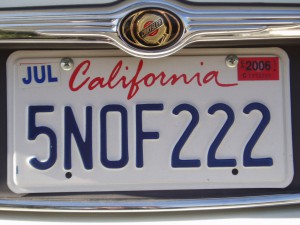U.S. license plates vs. EU’s: humor vs. efficiency?
Most of us have played the license plate game on long road trips, or taken a picture of a funny personalized plate like “IMLAWST” or “WHO5 HOT.” License plates do more than just entertain–they help our countries keep tabs on us in more ways than one.

Photo by Sergio Leenen via Flickr.
Interestingly enough, license plates were created before the dawn of the automobile and used on horse carriages. The earliest license plates were made of porcelain pressed into un-backed iron or ceramic materials; they were very fragile and could be destroyed on impact.
License plates were invented in France in the late 1890s, and eventually became standard in Europe. New York was the first state to pass license plate laws for horse-drawn carriages and tractors in 1901. The majority of American states following suit over the course of the next thirty years.
Throughout the world, the majority of governments require license plates on the front and back of automobiles. In the U.S., a plate must always appear on the rear bumper, though the number of license plates required (either one or two) varies. Individual states also have differing laws regarding out-of-state plates after relocation – for example, Florida residents moving to Rhode Island are permitted to keep their Florida license plates despite their place of residency, but RI citizens must surrender their plates upon leaving the state.

A California license plate. Photo by Steve Cadman via Flickr.
American Plates
Many drivers in the U.S. like to customize their own license plates. Compared to the European Union; the license plate regulations in the United States seem scattered and haphazard, with these vanity plates giving virtually no information about the car or its owner. Paying to customize license plates is not an option in the European Union, as the license plate reveals a great deal of information about the driver, his or her country of origin, and the car that he or she is driving.
In the United States however, the aforementioned vanity license plates let the motorist decide what text or numerals will appear on his or her license plate. When drivers choose against the added expense of a vanity plate, the letters and numbers on license plate are completely random. The number of characters permitted on a license plate also varies and is based on population; California tops the list with seven non-hyphenated characters.

A Tesla with a mocking license plate: “LOL OIL.” Photo by Aaron Anderer via Flickr.
European Plates
In the European Union, license plates are far more strict and organized. The vehicle registration plates in Europe underwent changes in 1998, when the Council Regulation decided on a standardized format for automobiles throughout the EU. These regulations follow this format:

A Berlin license plate. Photo by Jerry “Woody” via Flickr.
Catching Violators
This system makes ticketing easy and efficient. For example, if a driver decides to leave his car idling in a bus lane in London, a CCTV camera monitoring the lane will be able to identify the violation by scanning the license plate. Because cars and buses have different plate formats, the camera will know within seconds whether or not the vehicle in the bus lane is actually a bus. It will then take a video of the violation to be sent out to the traffic authorities. More violators are caught, more tickets handed out, and there is more revenue for the government. License plate recognition software can locate violators in fire lanes, bike lanes, and regulated parking areas.
Additionally, the E.U.’s system is much more organized than it is in America; the U.S. has to consult a wide database. It all but guarantees that there are no two license plates with the same information throughout the European Union, whereas in America there can be overlaps from state to state. By reducing confusion (they even exclude I, Z, and S, from the 3 random letters portion, in order to avoid confusion with the numbers 1, 2, and 5, respectively), the EU is able to keep a more regulated database of automobiles with a more accessible user interface.

EU plates are less humorous, but more efficient. Photo by mroach via Flickr.
Material
License plates in both the U.S. and Europe are generally required to be aluminum and retroreflective, allowing clear visibility in day and night hours. This regulation eases identification and ticketing for police officers and uses the same technology that is commonly used for road signage throughout the world.
Both the European Union and United States have strictly enforced laws regarding the ownership and display of vehicular identification.
Should the U.S. ever adopt the E.U.’s plate registration systems, traffic and parking violation revenues would increase, and the Secretary of Transportation’s job would probably become a little easier.
Category: Automotive, Enforcement, Resources, Trends













